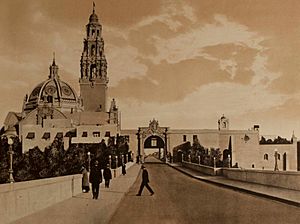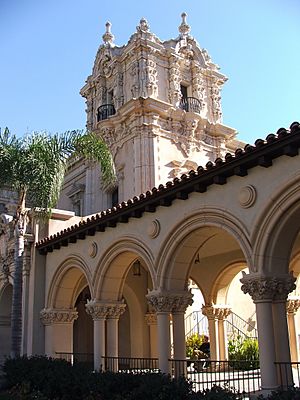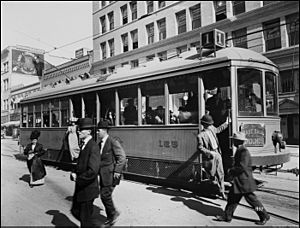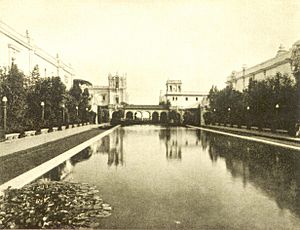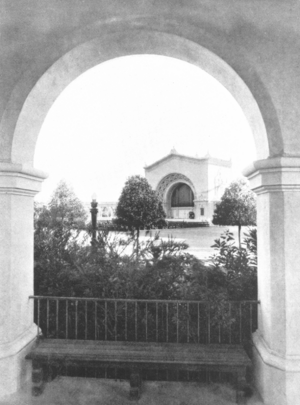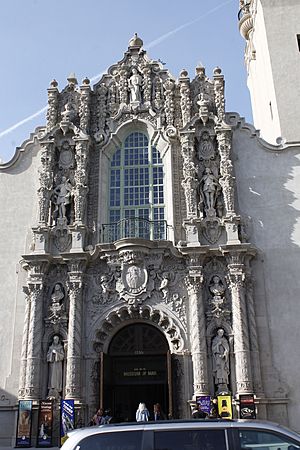Panama–California Exposition facts for kids
Quick facts for kids 1915–1916 San Diego |
|
|---|---|
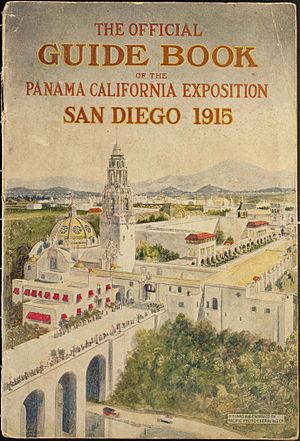
Official guide book
|
|
| Overview | |
| BIE-class | Unrecognized exposition |
| Name | Panama–California Exposition |
| Area | 640 acres (260 hectares) |
| Visitors | 3,747,916 |
| Organized by | Panama–California Exposition Company |
| Location | |
| Country | United States |
| City | San Diego |
| Venue | Balboa Park |
| Coordinates | 32°43′53″N 117°09′01″W / 32.73139°N 117.15028°W |
| Timeline | |
| Opening | January 1, 1915 |
| Closure | January 1, 1917 |
| Specialized expositions | |
| Simultaneous | |
| Other | Panama–Pacific International Exposition (San Francisco) |
The Panama–California Exposition was a big fair held in San Diego, California. It ran from January 1, 1915, to January 1, 1917. This fair celebrated the opening of the Panama Canal. It also aimed to show San Diego as the first U.S. port for ships coming from the canal. The fair took place in San Diego's large Balboa Park.
Contents
Planning the Big Fair
Why San Diego Hosted the Exposition
In 1909, a local businessman named Gilbert Aubrey Davidson suggested a fair. He wanted to celebrate the completion of the Panama Canal. San Diego was a small city then, with about 37,578 people. This made it the smallest city to host an international fair.
Meanwhile, San Francisco was much bigger. It also wanted to host the official Panama Canal fair. San Francisco had strong support from politicians. They even tried to get San Diego to stop its plans. But San Diego kept going with its own fair.
Funding the Exposition
San Diego's fair did not get much money from the government. So, it was smaller than San Francisco's fair. Fewer states and countries took part at first.
The Panama–California Exposition Company was created in September 1909. Its leaders included Ulysses S. Grant Jr. and John D. Spreckels. Later, David Charles Collier became president. He chose Balboa Park as the location. He also picked the unique Spanish-style buildings.
Collier wanted the fair to show human progress. He said it should be a "permanent contribution to the world's progress." In 1914, Davidson took over as president again.
By March 1910, the company raised $1 million (about $31,407,143 today). Voters also approved another $1 million for park improvements. The California State Building got $450,000 (about $14,133,214 today) from the state government.
Designing the Fairgrounds
Architects and Landscape
Fair officials first wanted architect John Galen Howard. When he was not available, they chose Bertram Goodhue in 1911. Irving Gill helped Goodhue at first. Later, Carleton Winslow joined the team.
The Olmsted Brothers were the first landscape designers. They were replaced by Frank P. Allen Jr.
Balboa Park's Transformation
The fair was built in Balboa Park, which was 1,400 acres (570 ha) big. Before the fair, the park was mostly open land. It had wildflowers and wild animals like bobcats.
In 1910, a contest renamed the park after Vasco Núñez de Balboa. He was the first European to see the Pacific Ocean from Central America.
Two canyons, Cabrillo Canyon and Florida Canyon, divide the park. Cabrillo Canyon separated the fair site from downtown San Diego.
Spanish Colonial Revival Style
Goodhue and Winslow chose a special architectural style. It was called Spanish Colonial Revival. This style used rich decorations from Mexico and Spain. It also had influences from Islamic and Persian designs.
This was new for American fairs. Most past fairs used neoclassical styles. Even San Francisco's fair mostly used a different style.
Goodhue had used Spanish Baroque in other places. He got ideas from buildings like the Giralda Tower in Seville, Spain. He also looked at the Mexico City Cathedral.
Goodhue designed the biggest building, the California Building. He also helped with other designs. The buildings showed the history of Spanish colonial styles in North America. The Botanical Building was designed like a Spanish Renaissance greenhouse.
This mix of styles became very popular in California. It is still used today. Before the fair, San Diego mostly had Victorian architecture. The fair made Spanish-style buildings more popular in the city.
Winslow continued to design buildings in this style. He helped Santa Barbara adopt it after an earthquake in 1925.
The fairgrounds also had many paths, small spaces, and courtyard Spanish gardens. Many of these gardens were meant to stay after the fair.
Building the Exposition
The groundbreaking ceremony for the fair was on July 19, 1911. Some city buildings were moved to make space. The first building, the Administration Building, was finished in March 1912. Visitors could pay $0.25 (about $7 today) to watch the construction.
Fair Layout and Features
Entrances and Main Areas
The 640-acre (260 ha) fair had three entrances. These were on the west, north, and east sides.
The East Gateway was for cars and trolley cars. It wound up from the city.
From the west, the Cabrillo Bridge led to the West Gate. This gate had figures symbolizing the Atlantic and Pacific oceans joining. These figures were made by Furio Piccirilli.
The North gate led to the 'Painted Desert'. This was a 5-acre (2.0 ha) exhibit with 300 Native Americans. They were from seven tribes, including the Apache and Navajo. The 'Painted Desert' looked like rock but was wire frames covered in cement.
The 'Isthmus' was a 2,500-foot (760 m) long street. It had games, rides, and a replica gem mine. There was also a 250-foot (76 m) replica of the Panama Canal. A "China Town" was also part of the Isthmus.
Buildings That Stayed
Some buildings were built to be permanent. These included the Cabrillo Bridge, the California State Building, and the Fine Arts Building. These are now part of the California Quadrangle. The Botanical Building was built to protect plants. The Spreckels Organ Pavilion was for outdoor concerts. The Botanical Building cost $53,400 (about $1,560,132 today).
The Cabrillo Bridge was a key part of the design. It was meant to be a lasting landmark.
The main area of the fair was the Plaza de California. This plaza often had Spanish dancers. The California State Building and the Fine Arts Building surrounded it. The California State Building had very detailed decorations. Its 200 feet (61 m) tower was a main feature.
Buildings That Were Temporary
Many buildings were meant to be temporary. They were designed to create a "dream-like" effect. These buildings were along El Prado, a wide, tree-lined street. El Prado was meant to become a public garden.
However, many of these "temporary" buildings were kept. Some were even rebuilt later. These include the House of Charm, the House of Hospitality, Casa del Prado, and Casa de Balboa. They are now part of the El Prado Complex.
Getting Around the Fair
Transportation was important for the fair. An electric railway ran near the east gate. New streetcars were built to handle the crowds. These streetcars connected many parts of San Diego. Today, only three of the original twenty-four streetcars remain.
Visitors could also rent small electric chairs called electriquettes. These slow-speed vehicles held two or three people. They helped visitors travel around the fair. Plans are being made to have replica electriquettes for the 2015 centennial.
Other Attractions
The fairgrounds had over two million plants of 1,200 types. Peacocks and pheasants roamed freely. Guests often fed pigeons.
At first, no foreign countries had buildings. A few U.S. states had exhibits. These included Kansas, Montana, and New Mexico. San Francisco's fair had exhibits from 22 countries. Many of these international exhibits came to San Diego in 1916.
The U.S. Marines, Army, and Navy also had exhibits. They held parades and mock battles.
Opening Day and Visitors
On December 31, 1914, at midnight, President Woodrow Wilson officially opened the fair. He pushed a telegraph button in Washington, D.C. This turned on the power and lights at the park. Guns fired at Fort Rosecrans and on Navy ships.
Admission was $0.50 (about $14 today) for adults. Children paid $0.25 (about $7 today). On opening day, between 31,836 and 42,486 people attended.
By April 1915, the fair had made a $40,000 (about $1,157,105 today) profit. By July, one million visitors had come.
Famous guests included Vice President Thomas R. Marshall and Franklin D. Roosevelt. Former presidents William Howard Taft and Theodore Roosevelt also visited. Inventor Thomas Edison and businessman Henry Ford were there too. The fair successfully made San Diego more famous. Even the Liberty Bell visited for three days in November 1915. By the end of 1915, over two million people had visited. The fair made a small profit of $56,570 (about $1,636,436 today).
Extending the Fair
Before 1915 ended, people wanted to extend the fair for another year. Funding for 1916 came from Los Angeles and local businesses. Money also came from the San Francisco fair.
On March 18, 1916, the fair was renamed the Panama–California International Exposition. This was because it now had international exhibits. Countries like Brazil, Canada, France, and Germany took part. Many exhibits came from the San Francisco fair. Some countries could not send their exhibits home because of World War I.
New attractions included an ice rink and an alligator farm. Some original buildings were used for new exhibits.
The fair ended on January 1, 1917. The final day had a military parade and an opera. At midnight, the lights turned off. Fireworks spelled "WORLD PEACE–1917". In its second year, the fair had almost 1.7 million visitors. Overall, the fair made a small profit.
Lasting Impact of the Fair
"It is so beautiful that I wish to make an earnest plea ... I hope that not only will you keep these buildings running for another year but you will keep these buildings of rare, phenomenal taste and beauty permanently."
In July 1915, former President Theodore Roosevelt asked San Diego to keep the fair buildings permanently.
Buildings That Remain Today
Many permanent buildings from the fair are still standing:
- Botanical Building: One of the largest structures covered with a lath roof. It holds many tropical plants. It is behind a long pool called La Laguna de Las Flores.
- Cabrillo Bridge: Finished in 1914, it spans a canyon.
- California Bell Tower: Completed in 1914, it is 198 feet (60 m) tall. It has a Spanish ship weathervane on top. It is a famous sight in San Diego.
- California State Building: Finished in 1914, it now houses the Museum of Us. Its design was inspired by a church in Guanajuato, Mexico.
- Chapel of St. Francis of Assisi: On the south side of the Fine Arts Building. It is now run by the Museum of Us.
- Fine Arts Building: On the south side of the Plaza of California. It is also part of the Museum of Us.
- Spreckels Organ Pavilion: Opened on December 31, 1914.
Balboa Park's Transformation
The fair greatly changed Balboa Park. Before the fair, it was mostly open land. The fair's landscaping and buildings turned it into a major cultural center. Today, it has many of San Diego's main museums.
The fair also led to the creation of the San Diego Zoo. It started with exotic animals left behind from the fair.
Military Presence in San Diego
During the fair, Franklin D. Roosevelt said San Diego would become a Navy port. This led to many Navy bases being built in San Diego. After the fair, the Army and Marines used some empty fair buildings.
| Exposition name | Later or alternate name | Notes |
|---|---|---|
| Administration Building (1915) | Gill Administration Building | (completed March 1912) now holds offices of the Museum of Us |
| Commerce & Industries Building (1915) | Canadian Building (1916); Palace of Better Housing (1935) | renamed Electrical Building and lost in a 1978 arson fire, reconstructed as the Casa de Balboa |
| Foreign Arts Building (1915) | altered and renamed House Of Hospitality in 1935, reconstructed to be permanent in 1997 | |
| Varied Industries & Food Products Building (1915) | Foreign & Domestic Building (1916); Palace of Food & Beverages (1935) | 1971 reconstruction named Casa del Prado |
| Montana State Building (1915) | demolished | |
| New Mexico State Building (1915) | Palace of Education (1935) | now used by Balboa Park Club |
| Home Economy Building (1915) | Pan-Pacific Building (1916) Cafe of the World (1935) | demolished; Timken Museum of Art built on site in 1965 |
| Indian Arts Building (1915) | Arts & Crafts Building (tentative); Russia & Brazil Building (1916) | rebuilt to exacting specification in 1996 as the House of Charm |
| San Joaquin Valley Building (1915) | demolished | |
| Science & Education Building (1915) | Science of Man exhibit, Palace of Science & Photography (1935) | demolished in 1964 (exhibit inspired creation of Museum of Us) |
| Southern California Counties Building (1915) | Civic Auditorium | burned down in 1925, replaced in 1933 with San Diego Natural History Museum |
| Kansas State Building (1915) | Theosophical Headquarters (1916); United Nations/House of Italy | designed in the spirit of Mission San Luis Rey in Oceanside |
| Sacramento Valley Building (1915) | United States Building (1916) | replaced by San Diego Museum of Art in 1926 |
| Painted Desert (1915) | later used by military and Boy Scouts; demolished in 1946 | |
| Washington State Building (1915) | demolished | |
| Santa Fe Depot Baggage Building (1915) | Jacobs Building (2007) | now used by Museum of Contemporary Art San Diego |
Later Fairs and Rebuilding
The California Pacific International Exposition was held at the same site in 1935. It was so popular that some buildings were rebuilt to last longer. Many buildings, or rebuilt versions, are still used today. They house museums and theaters in Balboa Park.
In the 1960s, some buildings were torn down. New, modern buildings replaced them. This made many San Diegans upset. In 1967, citizens formed "A Committee of One Hundred." They worked to protect the park buildings. They got the city to require new buildings to be in the Spanish Colonial Revival Style. In 1977, the remaining buildings were declared National Historic Landmarks. In the late 1990s, the most damaged buildings were rebuilt. They kept their original style.
Centennial Celebration
San Diego planned a big celebration for the fair's 100th anniversary in 2015. Park museums had special events. One idea was to remove cars from the central plazas. This plan was dropped due to legal issues. Still, many events and exhibits were held throughout 2015 to celebrate the centennial.
Exhibition Map
Images for kids
See also
 In Spanish: Exposición Panamá–California (1915) para niños
In Spanish: Exposición Panamá–California (1915) para niños


